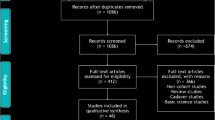Abstract
Introduction
Fractures of femoral fracture are among the most common fractures encountered in orthopedic practice. Intramedullary nailing is the treatment choice for femoral shaft fractures in adults. The objective of this article is to determine the effects of reamed intramedullary nailing versus unreamed intramedullary nailing for fracture of femoral shaft in adults.
Methods
Cochrane Central Register of Controlled Trials (October 2010), PubMed (October 2010) and EMBASE (October 2010) were searched. Randomized and quasi-randomized controlled clinical trials were included. After independent study selection by two authors, data were collected and extracted independently. The methodological quality of the studies was assessed. Pooling of data was undertaken where appropriate.
Results
Seven trials with 952 patients (965 fractures) were included. Compared with unreamed nailing, reamed nailing was significantly lower reoperation rate (RR 0.25, 95% CI 0.11–0.59, P = 0.002), lower non-union rate (RR 0.20, 95% CI 0.05–0.77, P = 0.02) and lower delay union rate(RR 0.30, 95% CI 0.14–0.64, P = 0.002). There was no significant difference when comparing reamed nailing with unreamed nailing for implant failure (RR 0.51, 95% CI 0.16–1.61, P = 0.25), mortality(RR 0.94, 95% CI 0.19–4.58, P = 0.94) and acute respiratory distress syndrome(RR 1.53, 95% CI 0.37–6.29, P = 0.55). Unreamed nailing was significantly less blood loss (SMD 119.23, 95% CI 59.04–180.43, P = 0.0001).
Conclusion
Reamed intramedullary nailing has better treatment effects than unreamed intramedullary nailing for shaft fracture of femur in adults.








Similar content being viewed by others
References
Weiss RJ, Montgomery SM, Al Dabbagh Z, Jansson KA (2009) National data of 6409 Swedish inpatients with femoral shaft fractures: stable incidence between 1998 and 2004. Injury 40(3):304–308. doi:10.1016/j.injury.2008.07.017
Bucholz RW, Jones A (1991) Fractures of the shaft of the femur. J Bone Joint Surg Am 73(10):1561–1566
Crist BD, Wolinsky PR (2009) Reaming does not add significant time to intramedullary nailing of diaphyseal fractures of the tibia and femur. J Trauma 67(4):727–734. doi:10.1097/TA.0b013e31819db55c
Schemitsch EH, Kowalski MJ, Swiontkowski MF, Harrington RM (1995) Comparison of the effect of reamed and unreamed locked intramedullary nailing on blood flow in the callus and strength of union following fracture of the sheep tibia. J Orthop Res 13(3):382–389. doi:10.1002/jor.1100130312
Leunig M, Hertel R (1996) Thermal necrosis after tibial reaming for intramedullary nail fixation. A report of three cases. J Bone Joint Surg Br 78(4):584–587
Wenda K, Runkel M, Degreif J, Ritter G (1993) Pathogenesis and clinical relevance of bone marrow embolism in medullary nailing—demonstrated by intraoperative echocardiography. Injury 24(Suppl 3):S73–S81
Reynders PA, Broos PL (2000) Healing of closed femoral shaft fractures treated with the AO unreamed femoral nail. A comparative study with the AO reamed femoral nail. Injury 31(5):367–371
Moed BR, Watson JT, Cramer KE, Karges DE, Teefey JS (1998) Unreamed retrograde intramedullary nailing of fractures of the femoral shaft. J Orthop Trauma 12(5):334–342
Pfister U (2010) Reamed intramedullary nailing. Orthopade 39(2):171–181
Higgins JP, Green S (2009) Cochrane handbook for systematic reviews of interventions Version 5.0.2 [updated September 2009]. The Cochrane Collaboration. http://www.cochrane-handbook.org. Accessed 14 March 2011
Higgins JP, Thompson SG, Deeks JJ, Altman DG (2003) Measuring inconsistency in meta-analyses. BMJ 327(7414):557–560. doi:10.1136/bmj.327.7414.557
Tornetta P 3rd, Tiburzi D (1997) The treatment of femoral shaft fractures using intramedullary interlocked nails with and without intramedullary reaming: a preliminary report. J Orthopaed Trauma 11(2):89–92
Clatworthy MG, Clark DI, Gray DH, Hardy AE (1998) Reamed versus unreamed femoral nails. A randomised, prospective trial. J Bone Joint Surg Br 80(3):485–489
Selvakumar K, Saw KY, Fathima M (2001) Comparison study between reamed and unreamed nailing of closed femoral fractures. Med J Malaysia 56(Suppl D):24–28
Shepherd LE, Shean CJ, Gelalis ID, Lee J, Carter VS (2001) Prospective randomized study of reamed versus unreamed femoral intramedullary nailing: an assessment of procedures. J Orthop Trauma 15(1):28–32 discussion 32–33
Canadian Orthopaedic Trauma Society (2003) Nonunion following intramedullary nailing of the femur with and without reaming: results of a multicenter randomized clinical trial. J Bone Joint Surg Ser A 85(11):2093–2096
Anwar IA, Battistella FD, Neiman R, Olson SA, Chapman MW, Moehring HD (2004) Femur fractures and lung complications: a prospective randomized study of reaming. Clin Orthop Relat Res (422):71–76
Canadian Orthopaedic Trauma Society (2006) Reamed versus unreamed intramedullary nailing of the femur: Comparison of the rate of ARDS in multiple injured patients. J Orthop Trauma 20(6):384–387
Roberts C, Torgerson D (1998) Randomisation methods in controlled trials. BMJ 317(7168):1301
Schulz KF, Chalmers I, Hayes RJ, Altman DG (1995) Empirical evidence of bias. Dimensions of methodological quality associated with estimates of treatment effects in controlled trials. JAMA 273(5):408–412
Schulz KF, Chalmers I, Altman DG (2002) The landscape and lexicon of blinding in randomized trials. Ann Intern Med 136(3):254–259
Sackett DL RW, Rosenberg W, Haynes RB (1997) Evidence-based medicine: how to practice and teach EBM, 1st edn. Churchill Livingstone, New York
Moher D, Schulz KF, Altman D (2001) The CONSORT statement: revised recommendations for improving the quality of reports of parallel-group randomized trials. JAMA 285(15):1987–1991. doi:jsc00437
Giannoudis PV, Tzioupis C, Pape HC (2006) Fat embolism: the reaming controversy. Injury 37(Suppl 4):S50–S58. doi:10.1016/j.injury.2006.08.040
Klein MP, Rahn BA, Frigg R, Kessler S, Perren SM (1990) Reaming versus non-reaming in medullary nailing: interference with cortical circulation of the canine tibia. Arch Orthop Trauma Surg 109(6):314–316
Weninger P, Figl M, Spitaler R, Mauritz W, Hertz H (2007) Early unreamed intramedullary nailing of femoral fractures is safe in patients with severe thoracic trauma. J Trauma 62(3):692–696. doi:10.1097/01.ta.0000243203.38466.e0
Saldua NS, Kuhn KM, Mazurek MT (2008) Thermal necrosis complicating reamed intramedullary nailing of a closed tibial diaphysis fracture: a case report. J Orthop Trauma 22(10):737–741. doi:10.1097/BOT.0b013e31818ccddf
Forster MC, Aster AS, Ahmed S (2005) Reaming during anterograde femoral nailing: is it worth it? Injury 36(3):445–449. doi:10.1016/j.injury.2004.07.031
Acknowledgments
Natrual Science Foundation of China, No:30973049.
Conflict of interest
None.
Author information
Authors and Affiliations
Corresponding author
Rights and permissions
About this article
Cite this article
Duan, X., Li, T., Mohammed, AQ. et al. Reamed intramedullary nailing versus unreamed intramedullary nailing for shaft fracture of femur: a systematic literature review. Arch Orthop Trauma Surg 131, 1445–1452 (2011). https://doi.org/10.1007/s00402-011-1311-8
Received:
Published:
Issue Date:
DOI: https://doi.org/10.1007/s00402-011-1311-8




